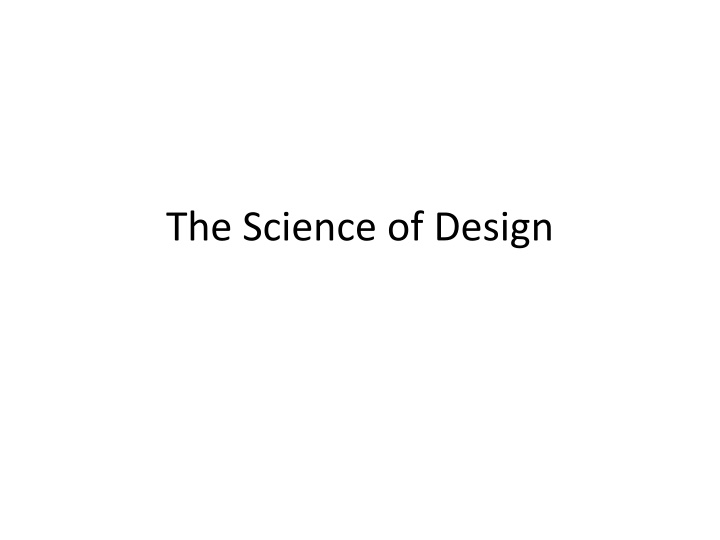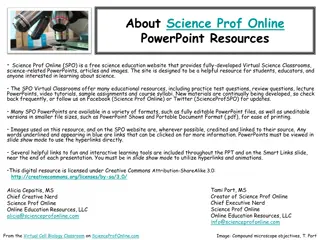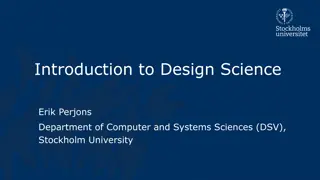
Unveiling the Science of Design
Delve into the fascinating world of design through the lens of science and engineering. Explore the intricacies of representing goals, satisficing, finding alternatives, and the challenges of designing design itself. Uncover the coevolution of problem and solution spaces, hierarchic resource allocation, and the hierarchy as an outcome. Gain insights into the process of idea generation, artifact creation, and decision-making in the realm of design. Discover the complexities of balancing incomplete, contradictory, and changing requirements in design processes, and the quest for optimal solutions in a dynamic environment.
Download Presentation

Please find below an Image/Link to download the presentation.
The content on the website is provided AS IS for your information and personal use only. It may not be sold, licensed, or shared on other websites without obtaining consent from the author. If you encounter any issues during the download, it is possible that the publisher has removed the file from their server.
You are allowed to download the files provided on this website for personal or commercial use, subject to the condition that they are used lawfully. All files are the property of their respective owners.
The content on the website is provided AS IS for your information and personal use only. It may not be sold, licensed, or shared on other websites without obtaining consent from the author.
E N D
Presentation Transcript
What is Design? Science vs. Engineering Science teaches about natural things where engineering teaches about artificial things Design vs. Engineering Engineering used to be more about design but, like many other professional disciplines, became taught more as (applied) math and science Design vs. Art Design teaches process of idea generation and artifact creation Where do you learn about design in Computer Science?
Representing Goals Need for imperative logic Paradoxes of using declarative logic for imperative statements Optimization methods Command variables represent inner design Quantities of foods Outer environment represented as probability distributions Prices of foods, nutritional contents Utility function computes goodness of particular set of command variables for expected context Nutritional requirements, cost of diet
Satisficing Some design settings overload computing requirements Approximation algorithms Many design settings do not enable enumerable goals and environmental variables Density of acceptable solutions determines how long search will take
Finding Alternatives How to decide which potential designs to examine? General Problem Solver (GPS) Represent differences between current state and desired state Determine actions likely to reduce that difference Best-first search Avoiding local maxima Examine some non-best paths (e.g. simulated annealing) Combine the features of known good alternatives (e.g. genetic algorithms)
Designing Design But defining the problem is the problem Coevolution of problem and solution spaces Wicked problems (Horst Rittel) Incomplete, contradictory, and changing requirements Hierarchic resource allocation in design Progressively design from very general to precise Each step decides how much resources to put in subdesigns Can decide how much effort to expend in collecting additional information in human design processes Estimations of utility and future costs are difficult
Hierarchy as Outcome Design decomposition Semi-independent components Alternative decompositions How independent are components? Design style may reflect process more than goals Variety may be desirable end in itself Designs are not independent (e.g. in architecture, business, evolution)
Representation of Design Alternative representations and equivalence Chess board problem Number scrabble and tic-tac-toe Changing the representation may be part of design process McGuckins example of heaters -> door solving a problem simply means representing it so as to make the solution transparent Does this assume perfect knowledge?
Topics in the Theory of Design 1. Evaluating alternatives 2. Optimal/satisficing algorithms 3. Formal logic of design 4. Heuristic search 5. Resource allocation for search 6. Hierarchic organizations 7. Representation of problems avoid cookbook approaches But where is the boundary?
Social Planning Designing the Evolving Artifact
Designing on a Societal Scale Many visions of alternative organizations of society described In books: Plato, More, Marx By revolutionaries: America, France, Russia Large scale plans for the physical environment (e.g. river valleys) Going to the moon vs. social design As there is some degree of depravity in mankind which requires a certain degree of circumspection and distrust, so there are other qualities in human nature which justify a certain portion of esteem and confidence.
Problem Representation Alternative views of Marshall Plan Commodity screening, balance of trade, European cooperation, bilateral pledge, investment bank, policy & administration Variety of representation can paralyze decision Conflicting assumptions Resource limits Need a representation so parties can act on creating and making use of new system
Limiting Resources Are not always obvious Example of message traffic Scarcity of information vs. scarcity of attention What are the limiting resources in current AI assistant and big data visions? May not be able to quantitatively reason about limiting resources Example of emission standards Number of cars, how far they are driven, their design/cost, quality of air as function of emissions and other features, effects on human health and quality of life Qualitative vs. quantitative goals and representations
Data for Planning Need to incorporate assessment of data quality into process Good predictions require Theoretical understanding of phenomena Reliable data regarding initial conditions Club of Rome predictions (Malthusian catastrophe) Too much specific dates not believable Too little did not consider alternative futures (e.g. technical advances) Paul Kennedy s Preparing for the 21stCentury Predictions about aging population
How do we Plan in Such Situations Unrealistic to believe we can make accurate long-term predictions Evil Spock s social determinism Need short-term, medium-term and long-term goals and designs to enable feedback Can assess whether External system is proceeding as expected Design is operating as desired
The Client? Professions have adapted to bounded rationality Impact of client access to more information? Architect as teacher, advocate and (not just) executor Dual role of artist and professional he wasn t very happy at first. But then we smoked some good cigars, and we drank some glasses of a good Rhein wine, and then he began to like it very much. Medical profession Challenge of balancing the cost and quality of medical care
Planning and Society Society is not a passive instrument It will adapt to changes Game between planners and individuals (e.g. tax codes) Belonging to organizations Restricts liberties Attain goals (freedoms) that could not reach otherwise
Time and Space Horizons Metaphor of lamp in a long hall Discounting the future to make the problem tractable Lack of concern about future may be rational Unable to predict accurately Consequences will be defuse Society moving to longer-scale thinking/planning Oil policy: Reduce dependence, exhaust supply, global warming Amount of information can overwhelm decision makers
Challenge to Long-term Planning Two issues Needs of present takes precedence over long- term planning Good planners called in for immediate tasks If sufficiently isolated to do long-term work May be too isolated and no one listens
Designing without Final Goals Goals can be intermediate Lead to new goals (e.g. get a CS degree) Result of near-term actions creates environment for next stage Evolution as model for social planning Does evolution have a direction? Simon hypothesizes towards variety and complexity (not progress!) Gould would disagree except for initial stage and around punctures in equilibrium
Curriculum for Social Design 1. Bounded rationality 2. Data for planning 3. Identifying client 4. Organizations in social design 5. Time and space horizons 6. Designing without final goals






















